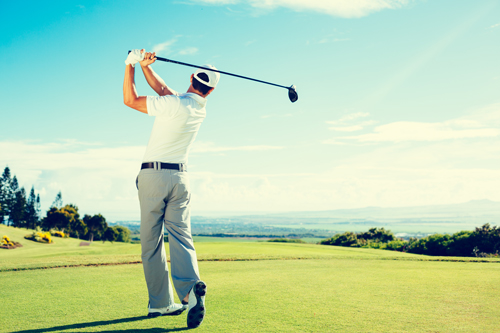
What is Country Club Elbow?
Country Club Elbow causes pain and inflammation on the inner side of the elbow. It is specifically linked to activities that involve repetitive wrist flexion and forearm rotation.
The term “country club elbow” might bring to mind pleasant images of green lawns, polo shirts, and tall glasses of iced tea.
Unfortunately, this name actually refers to a far less enjoyable condition: the combination of tennis elbow and golfer’s elbow—a chronic, painful syndrome associated with the two sports.
Differentiating Tennis and Golfer’s Elbow:
- Golfer’s Elbow (Medial Epicondylitis): Pain is felt on the inside of the elbow.
- Tennis Elbow (Lateral Epicondylitis): Pain is felt on the outside of the elbow.
It’s not uncommon for patients to experience pain in both regions, suggesting a diagnosis of country club elbow.
However, with proper care, most patients can be pain-free within a year.
Causes and Diagnosis
Country club elbow is categorized as an overload or overuse injury. Previously believed to be caused by tendon inflammation, it’s now thought to result from scar tissue formed due to repetitive strain or unnoticed minor trauma.
Common risk factors include:
- Age (30-50)
- Repetitive wrist movements
- Poor technique during sports or work tasks
- Inadequate warm-up exercises
Diagnosing country club elbow requires a comprehensive evaluation by a qualified healthcare professional. This may involve physical examinations to assess the elbow’s range of motion, specific tests to evaluate the strength and stability of the affected area, and imaging tests to rule out other potential causes.
Symptoms
Typical symptoms include:
- Pain and tenderness on the inner side of the elbow
- Pain radiating down the forearm
- Intensified pain with activities involving gripping, lifting, or bending the wrist
- Possible weakness in the affected arm
Treating Country Club Elbow
Initial Relief
To manage the immediate pain and inflammation associated with country club elbow, consider these strategies:
- Application of Ice: Apply ice to the affected area for 15-20 minutes several times a day. This can help reduce inflammation and numb the area, providing temporary relief.
- Rest: Give your elbow a break from activities that exacerbate the pain. Avoid repetitive wrist and forearm movements to prevent further strain.
- Nonsteroidal Anti-Inflammatory Drugs (NSAIDs): Medications like ibuprofen or naproxen can help reduce inflammation and pain. Always consult your physician before taking any medication to ensure it’s safe for you.
Advanced Treatments
If initial relief measures aren’t enough, more advanced treatments may be necessary:
- Corticosteroid Injections: These injections can provide powerful anti-inflammatory effects and pain relief. They are usually considered when other treatments have failed to bring sufficient relief.
- Surgery: In extreme cases where other treatments have not been effective, surgery may be recommended. The surgical procedure involves removing damaged tissue and relieving pressure on the tendons.
Rehabilitation Program
A tailored rehabilitation program is the cornerstone of effective treatment for country club elbow. This program focuses on manipulating the elbow and strengthening the tendons around the joint.
Key components include:
- Stretching: Regular stretching exercises can improve flexibility and reduce stiffness. Focus on gentle stretches that target the forearm, wrist, and elbow.
- Eccentric Exercise: This form of weight-bearing resistance training involves lengthening the muscle as it contracts. Eccentric exercises can help strengthen the tendons and improve their resilience.
- Therapeutic Modalities: Incorporate techniques such as massage, ultrasound therapy, and manual therapy to alleviate pain and promote healing. Your physical therapist can guide you through these treatments.
Efficacy of Physical Therapy
Although steroid injections might offer additional relief in some cases, studies have shown that physical therapy alone is the most effective treatment for both tennis and golfer’s elbow.
Your physical therapist will design a personalized program that includes:
- Strengthening Exercises: Focus on exercises that strengthen the muscles and tendons around the elbow. These exercises can help prevent future injuries.
- Flexibility Training: Improving flexibility in the forearm and wrist can reduce strain on the elbow tendons.
- Manual Therapy: Techniques like massage and mobilization can help reduce pain and improve range of motion.
If you’re ready to take the next step toward recovery, our experienced team at The Jackson Clinics is here to help. We can provide you with the personalized care you need to get back to your favorite activities, pain-free.
Check out our list of 18 Northern Virginia locations to find one near you!
Lifestyle Modifications
In addition to formal treatments, making certain lifestyle changes can support your recovery and prevent recurrence:
- Ergonomic Adjustments: Ensure that your work and sports equipment are ergonomically designed to reduce strain on your elbow. This might include adjusting your workstation or using equipment that better fits your body mechanics.
- Proper Technique: Whether you’re playing sports or performing repetitive tasks at work, using the correct technique can significantly reduce the risk of injury. Consider taking lessons or seeking professional advice to improve your form.
- Gradual Progression: If you’re returning to activities like golf or tennis, do so gradually. Start with shorter sessions and slowly increase the intensity and duration of your activities.
Preventing Country Club Elbow
To prevent country club elbow, consider making certain lifestyle changes can support your recovery and prevent recurrence.
- Ergonomic Adjustments: Ensure that your work and sports equipment are ergonomically designed to reduce strain on your elbow. This might include adjusting your workstation or using equipment that better fits your body mechanics.
- Proper Technique: Whether you’re playing sports or performing repetitive tasks at work, using the correct technique can significantly reduce the risk of injury. Consider taking lessons or seeking professional advice to improve your form.
- Gradual Progression: If you’re returning to activities like golf or tennis, do so gradually. Start with shorter sessions and slowly increase the intensity and duration of your activities.
Returning to Activities
By following a rehabilitation program and adopting better ergonomic techniques for the activities that caused the problem initially, you’ll be back to enjoying golf, tennis, or simply sipping iced tea in your polo shirt sooner than you think.
If you have any concerns or need further guidance, reach out to our experienced team today.
Did you know you have Direct Access* to Physical Therapy? No referral, no problem!

















